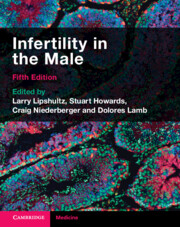Book contents
- Infertility in the Male
- Infertility in the Male
- Copyright page
- Contents
- Contributors
- Foreword
- Abbreviations
- Introduction
- Section 1 Scientific Foundations of Male Infertility
- Section 2 Clinical Evaluation of the Infertile Male
- Section 3 Laboratory Diagnosis of Male Infertility
- Section 4 Treatment of Male Infertility
- Chapter 21 Medical Treatment of Male Infertility
- Chapter 22 Surgery to Improve Sperm Delivery
- Chapter 23 Sperm Retrieval Surgery
- Chapter 24 The Use of Sperm in Medically Assisted Reproduction
- Chapter 25 Male Oncofertility – Considerations for Fertility Preservation and Restoration
- Chapter 26 Male Contraception
- Chapter 27 Future Directions in Male Infertility
- Section 5 Health Care Systems and Culture
- Index
- References
Chapter 21 - Medical Treatment of Male Infertility
from Section 4 - Treatment of Male Infertility
Published online by Cambridge University Press: 08 July 2023
- Infertility in the Male
- Infertility in the Male
- Copyright page
- Contents
- Contributors
- Foreword
- Abbreviations
- Introduction
- Section 1 Scientific Foundations of Male Infertility
- Section 2 Clinical Evaluation of the Infertile Male
- Section 3 Laboratory Diagnosis of Male Infertility
- Section 4 Treatment of Male Infertility
- Chapter 21 Medical Treatment of Male Infertility
- Chapter 22 Surgery to Improve Sperm Delivery
- Chapter 23 Sperm Retrieval Surgery
- Chapter 24 The Use of Sperm in Medically Assisted Reproduction
- Chapter 25 Male Oncofertility – Considerations for Fertility Preservation and Restoration
- Chapter 26 Male Contraception
- Chapter 27 Future Directions in Male Infertility
- Section 5 Health Care Systems and Culture
- Index
- References
Summary
Medical treatment of male infertility can be divided into two categories – targeted therapy to a known cause of infertility and empirical treatment. The most common reason to use targeted therapy is to treat hypoandrogenism. Primary hypoandrogenism (steroidogenic dysfunction) is defined as a low serum testosterone level with compensatory elevated luteinizing hormone (LH) level. Secondary hypoandrogenism (pituitary dysfunction) can be categorized further into congenital forms, such as idiopathic hypogonadotropic hypoandrogenism, or acquired forms and is characterized by low serum testosterone level associated with a low LH level relative to serum testosterone level. Other medical indications for targeted therapy are infections, inflammation, antisperm antibodies, and retrograde ejaculation, all of which are discussed elsewhere in this book. Empirical treatment is defined as treatment that relies on experience or observation alone, without due regard for system and theory, and it is routinely used in the treatment of males with idiopathic infertility or with an uncorrectable cause of their infertility.
- Type
- Chapter
- Information
- Infertility in the Male , pp. 399 - 412Publisher: Cambridge University PressPrint publication year: 2023



